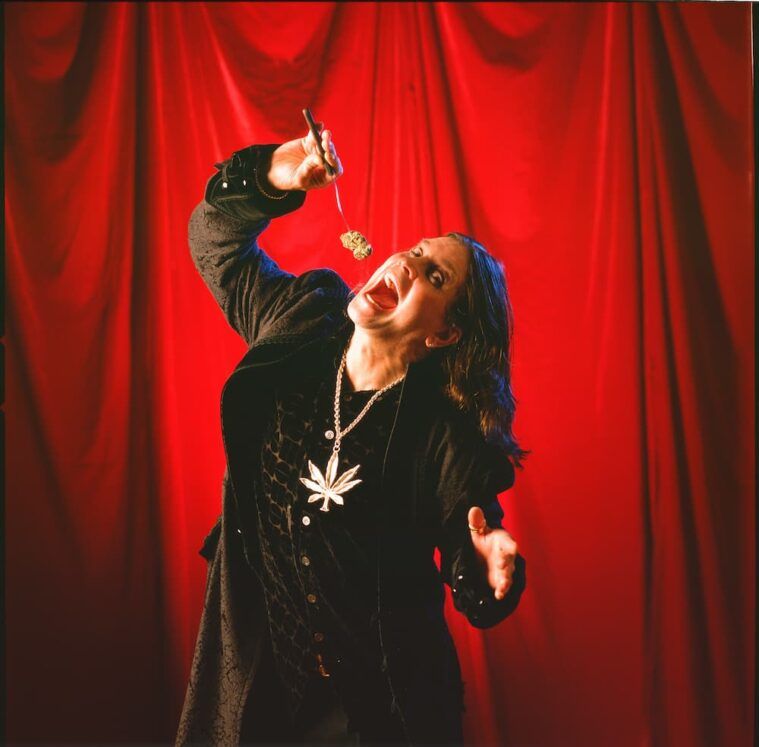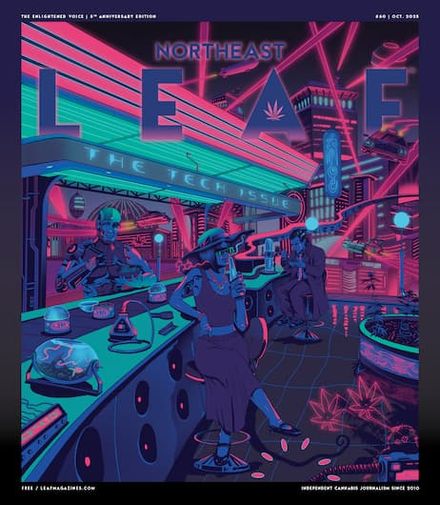Sabbath’s Sweet Leaf
With their doomy down-tuned riffs, profound lyrics and occult imagery, Black Sabbath is the undisputed progenitor of heavy metal. During their 55-year career, Sabbath sold over 75 million records, epitomized the excesses of the rock star lifestyle and inspired generations of young headbangers. They also happened to craft the greatest stoner rock anthem of all time.

Back to the Beginning
Sabbath’s story begins in the early 1960s in the industrial town of Birmingham, England, with aspiring teen guitarist Tony Iommi. By day, Iommi worked at a sheet metal factory, but by night, he was moonlighting in local bar bands. At 17, he quit his job to pursue music full time, but during his final shift, he accidentally sliced off the tips of two of his fingers. He was devastated, believing he’d never play again, but then he devised an ingenious solution: building prosthetic fingertips out of melted plastic wrapped in leather.
In January 1968, Iommi and his drummer friend, Bill Ward, joined a blues-rock band called Mythology. It was at the group’s shared apartment/rehearsal space up in Carlisle where they first started growing their hair long and smoking weed and hash. But after their dealer left two briefcases of weed at their flat, the band got busted and were forced to break up.
Nativity in Black
Determined to start a new band, Iommi and Ward answered a posting on the bulletin board at the local music store that July that read: “Ozzy Zig requires gig — has his own PA.” They walked to the address, where they met 19-year-old John Michael “Ozzy” Osbourne, who happened to be an old schoolmate of Iommi’s.
Growing up with dyslexia and undiagnosed ADHD, Osbourne was bullied and didn’t do well in school, dropping out at 15. As a result, he started drinking and became somewhat of a delinquent. Several petty thefts eventually landed him a six-week stint in prison, where he got his infamous O-Z-Z-Y knuckle tattoos at the age of 17. He worked a series of factory and construction jobs, but he had dreamed of becoming a rock star since first hearing the Beatles in 1962.
As it happened, Osbourne and his rhythm guitarist buddy Terence “Geezer” Butler had also recently left their band. Butler agreed to switch to bass, and the four of them started jamming. They played for nearly a year as Earth before learning in August 1969 that there was another band called Earth and deciding they needed a new name. Then one night, Butler noticed a line outside the movie theater across from their rehearsal space for an Italian horror film starring Boris Karloff called “Black Sabbath.” Realizing that people enjoyed being scared, he wrote a song using the name of the film, based on a nightmarish vision he’d recently experienced (after going to sleep high) wherein a big black figure pointed at him menacingly from the foot of his bed.
To fit the frightening lyrics, Iommi wrote an ominous riff utilizing a series of notes featuring a tritone — also known as “the devil’s interval.” The band liked this sinister sound so much that they decided to build their whole musical persona around it, developing a dark, doomy new style of rock that was the antithesis of the hippie/flower power aesthetic and rechristening themselves Black Sabbath. Thus, heavy metal was born.
Masters of Reality
By November 1969, Sabbath were already signed and recording their self-titled debut, which they completed in just one day. Playing up their horror theme, the album was released on Friday the 13th in February 1970. Just four months later, they were back in the studio working on the follow-up, “Paranoid.” Released that September, their sophomore effort featured some of Sabbath’s most iconic classics, including “Iron Man,” “War Pigs” and, of course, the title track, which became their first single. “Paranoid” went on to hit No. 1 on the U.K. charts and is widely considered to be the most influential metal album of all time. But it would be Sabbath’s next record that would cement their status as stoner icons.
In February 1971, Sabbath began work on their third album in as many years, “Master of Reality.” This record differed from their previous releases in several ways, starting with Iommi’s guitar sound. For the first time, he tried tuning his signature Gibson SG down from the standard E to C#. This loosening of the strings made them less painful to play and produced a deeper, sludgier tone that would become a new hallmark of Sabbath’s sound.
Another significant difference was that they had three months to record the album, rather than a day or two, allowing them the freedom to experiment by incorporating new elements, such as overdubbing, classical guitar (“Orchid”) and even flute (“Solitude”).
In addition to more time, they also had more money. Vertigo Records reportedly gave them a briefcase full of cash, the majority of which they allegedly spent on drugs — including massive quantities of marijuana.
“We used to smoke pounds of the shit, man,” Osbourne confessed in Sabbath’s legendary 1999 interview with High Times. “We used to buy it by the fuckin’ sackful. We used to be so fucked up all the time. Wake up in the morning, start the day with a spliff and go to bed with it …” The band was smoking so much weed, in fact, that they ended up writing a love letter to the plant.

Sweet Leaf
As legend has it, Butler was inspired to write a song in praise of the herb after seeing the tagline “Sweet Leaf” inside a pack of cigarettes. Thinking the term was a perfect nickname for marijuana, they reportedly retooled a love song they’d been working on into an ode to the herb:
“You introduced me to my mind / And left me wanting you and your kind … Straight people don’t know what you’re about / They put you down and shut you out / You gave to me a new belief / And soon the world will love you sweet leaf.”
As for the coughing in the song’s intro? That was Iommi, after taking a hit from a big joint Osbourne had handed him. “He said, ‘Just have a toke on this one,’’’ Iommi recalled in his autobiography “Iron Man.” “It bloody choked me! I coughed my head off, they taped that and we used it on the beginning of ‘Sweet Leaf.’”
Snowblind
Where “Master of Reality” had been influenced primarily by buds and booze, their next album — 1972’s “Vol. 4” — was fueled by their newest obsession: cocaine.
Through the rest of the 1970s, Sabbath recorded four more albums, toured relentlessly and began to get, as one interviewer put it, “lost in the excess.” Unsurprisingly, getting trashed all day, every day eventually began to take its toll on their productivity.
“We’d go down to the sessions and have to pack up because we were too stoned,” Iommi once admitted. “Nobody could get anything right, we were all over the place, everybody’s playing a different thing.”
By 1978, they were so strung out that it took them a year to finish their eighth album, “Never Say Die!” And while all of the guys were getting high, Iommi claims that Osbourne “was on a totally different level altogether.” Drunk and coked to the gills every day, unable to rehearse, disappearing for long stretches of time and outright refusing to sing on two of the tracks, Osbourne had become a liability. Finally, on April 27, 1979, Ward broke the news to him that he was fired.
Born Again
Following Osbourne’s departure, Sabbath recruited vocalist Ronnie James Dio and released two fantastic albums, “Heaven and Hell” (1980) and “Mob Rules” (1981). After that, Iommi continued releasing records under Sabbath’s name with various lineups.
As for Ozzy, he went on to cultivate a stellar solo career and a reputation as a madman, thanks to infamous antics such as biting the heads off of a dove and a bat, pissing on the Alamo and attempting to strangle his wife, Sharon. Yet, with her help, he remained highly productive and successful, releasing 12 solo albums, organizing the annual Ozzfest festival in 1996 and launching the hit reality show “The Osbournes” in 2006.
Sabbath later reunited with Ozzy several times, including for Live Aid in 1985 and for a full tour (as part of Ozzfest) and a live album (aptly titled “Reunion”) in 1998. Then, in November 2011, they announced that they would be recording new material together. Their last studio album, “13” (June 2013), hit No. 1, was certified gold and earned them a Grammy. In January 2016, they embarked on their final tour, titled “The End,” after which they officially disbanded in March 2017.

The End
In 2003, Ozzy was diagnosed with Parkinson’s Disease. That, along with spinal injuries, ultimately left him unable to walk in late 2024. Aside from a few necessary painkillers, he’d reportedly been sober since 2013 … or rather, California sober. Last year, in an episode of his podcast “The Madhouse Chronicles,” Osbourne confessed that he still enjoyed the sweet leaf “from time to time.”
“I said to Sharon that I’d smoked a joint recently, and she said, ‘What are you doing that for? It’ll fucking kill you!’” Ozzy told The Sun in 2023. “I said, ‘How long do you want me to fucking live for? At best, I’ve got ten years left.’”
But before checking out, Osbourne had one more item to cross off his bucket list: “I just want to be well enough to do one show where I can say, ‘Hi guys, thanks so much for my life,’ Osbourne told Rolling Stone in 2023. “If I drop down dead at the end of it, I’ll die a happy man.”
And so, on July 5, Black Sabbath staged one final performance in their hometown of Birmingham. Dubbed “Back to the Beginning,” their 10-hour farewell concert quickly ballooned into the greatest heavy metal show of all time, featuring dozens of rock’s biggest names paying tribute to the godfathers of metal in front of a crowd of 42,000 screaming fans. Seventeen days later, Ozzy Osbourne’s soul passed into the void at his home in Buckinghamshire.
Rest in power, Prince of Darkness.









